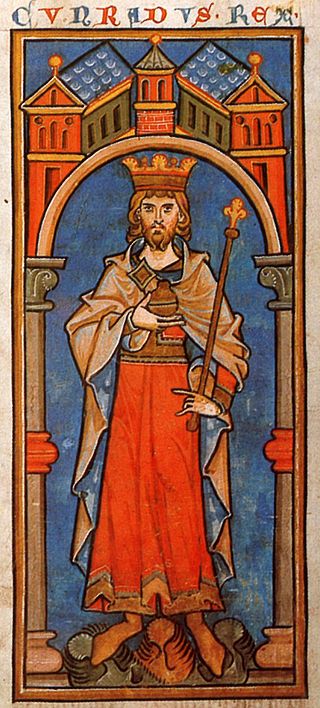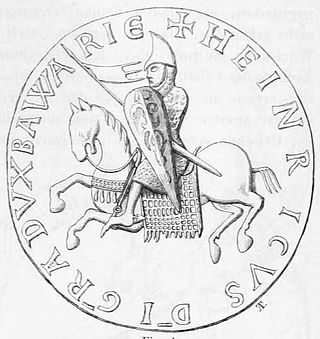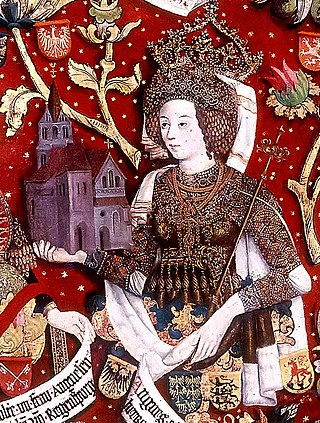
The Hohenstaufen dynasty, also known as the Staufer, was a noble family of unclear origin that rose to rule the Duchy of Swabia from 1079, and to royal rule in the Holy Roman Empire during the Middle Ages from 1138 until 1254. The dynasty's most prominent rulers – Frederick I (1155), Henry VI (1191) and Frederick II (1220) – ascended the imperial throne and also reigned over Italy and Burgundy. The non-contemporary name of 'Hohenstaufen' is derived from the family's Hohenstaufen Castle on Hohenstaufen mountain at the northern fringes of the Swabian Jura, near the town of Göppingen. Under Hohenstaufen rule, the Holy Roman Empire reached its greatest territorial extent from 1155 to 1268.

Lothair III, sometimes numbered Lothair II and also known as Lothair of Supplinburg, was Holy Roman Emperor from 1133 until his death. He was appointed Duke of Saxony in 1106 and elected King of Germany in 1125 before being crowned emperor in Rome. The son of the Saxon count Gebhard of Supplinburg, his reign was troubled by the constant intriguing of the Hohenstaufens, Duke Frederick II of Swabia and Duke Conrad of Franconia. He died while returning from a successful campaign against the Norman Kingdom of Sicily.

Conrad III of the Hohenstaufen dynasty was from 1116 to 1120 Duke of Franconia, from 1127 to 1135 anti-king of his predecessor Lothair III, and from 1138 until his death in 1152 King of the Romans in the Holy Roman Empire. He was the son of Duke Frederick I of Swabia and Agnes, a daughter of Emperor Henry IV.
Henry the Proud, a member of the House of Welf, was Duke of Bavaria from 1126 to 1138 and Duke of Saxony as well as Margrave of Tuscany and Duke of Spoleto from 1137 until his death. In 1138 he was a candidate for the election as King of the Romans but was defeated by Conrad of Hohenstaufen.

The House of Welf is a European dynasty that has included many German and British monarchs from the 11th to 20th century and Emperor Ivan VI of Russia in the 18th century. The originally Franconian family from the Meuse-Moselle area was closely related to the imperial family of the Carolingians.

Frederick II, called the One-Eyed, was Duke of Swabia from 1105 until his death, the second from the Hohenstaufen dynasty. His younger brother Conrad was elected King of the Romans in 1138.

Henry II, called Jasomirgott, a member of the House of Babenberg, was Count Palatine of the Rhine from 1140 to 1141, Duke of Bavaria and Margrave of Austria from 1141 to 1156, and the first Duke of Austria from 1156 until his death.

Agnes of Waiblingen, also known as Agnes of Germany, Agnes of Franconia and Agnes of Saarbrücken, was a member of the Salian imperial family. Through her first marriage, she was Duchess of Swabia; through her second marriage, she was Margravine of Austria.

Agnes of Babenberg was a scion of the Franconian House of Babenberg and by marriage High Duchess of Poland and Duchess of Silesia.
Otto of Nordheim was Duke of Bavaria from 1061 until 1070. He was one of the leaders of the Saxon revolt of 1073–1075 and the Saxon revolt of 1077–1088 against King Henry IV of Germany.

Henry IX, was a member of the House of Welf, a powerful dynasty in medieval Germany. He was born around 1075 and died in 1126. Henry IX is often referred to as “Henry the Black” and ruled as Duke of Bavaria from 1120 until his death in 1126.

Soběslav I was Duke of Bohemia from 1125 until his death in 1140. He was a member of the Přemyslid dynasty, the youngest son of Vratislaus II, by his third wife Świętosława of Poland.

Richenza of Northeim was Duchess of Saxony from 1106, Queen of Germany from 1125 and Holy Roman Empress from 1133 as the wife of Lothair of Supplinburg.

Gertrude of Süpplingenburg was Duchess of Bavaria, Margravine of Tuscany, and Duchess of Saxony by marriage to Henry X, Duke of Bavaria, and Margravine of Austria and Duchess of Bavaria by marriage to Henry II, Duke of Austria. She was regent of Saxony during the minority of her son Henry the Lion in 1139–1142.

Elisabeth of Bavaria was Queen of Germany and Jerusalem from 1246 to 1254 by her marriage to King Conrad IV of Germany.

Gertrude of Sulzbach was German queen from 1138 until her death as the second wife of the Hohenstaufen king Conrad III.

Gertrude Anne of Hohenberg was German queen from 1273 until her death, by her marriage with King Rudolf I of Germany. As queen consort, she became progenitor of the Austrian House of Habsburg.
Conrad I, called the Great, a member of the House of Wettin, was Margrave of Meissen from 1123 and Margrave of Lusatia from 1136 until his retirement in 1156. Initially a Saxon count, he became the ruler over large Imperial estates in the Eastern March and progenitor of the Saxon electors and kings.

Gertrude of Babenberg, a member of the House of Babenberg, was Duchess consort of Bohemia from 1140 until her death, by her marriage to the Přemyslid duke Vladislaus II.















